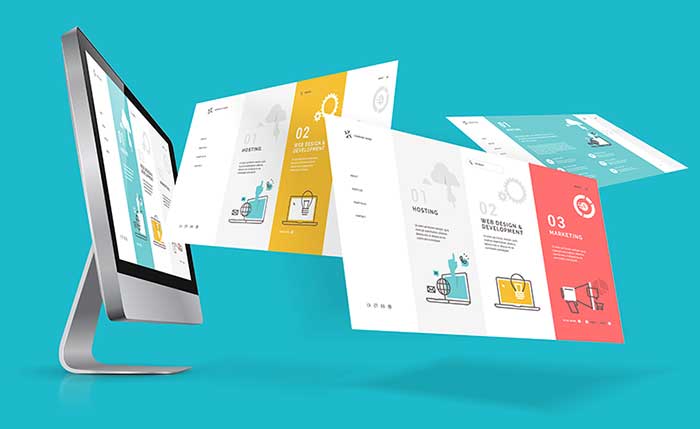Recognizing Individual Experience: Key Concepts for Successful Website Design
In the realm of web layout, understanding individual experience (UX) is vital to producing systems that not just draw in however additionally retain customers. Secret concepts such as intuitive navigation and effective responses devices play critical duties in promoting customer complete satisfaction. Additionally, factors to consider for access guarantee that all individuals can engage with the material effortlessly.
Value of Customer Experience

In the world of internet layout, one can not underestimate the relevance of user experience (UX) as an essential component that straight affects the success of a web site. A favorable UX not just boosts customer satisfaction yet likewise fosters commitment, encouraging repeat brows through and interactions. When customers experience a instinctive and interesting user interface, they are more most likely to discover the web content, transform into consumers, or share their experiences with others. This natural promotion can dramatically magnify a brand name's reach and visibility.
Furthermore, the value of UX expands beyond plain appearances. It includes the total capability of a site, ensuring that navigating is seamless and information is conveniently accessible. Sites that prioritize UX are often perceived as more credible and reputable, which can have a profound impact on conversion prices. In comparison, inadequate UX can result in frustration, causing high bounce rates and lost chances.
Ultimately, spending in customer experience is not just a layout selection; it is a tactical decision that can separate a brand in a congested marketplace. By concentrating on UX, organizations can develop meaningful communications that resonate with users, leading the way for continual success in the electronic landscape.
Use Principles
Effective website design rests on the application of essential usability principles that make certain a web site is both straightforward and useful. Central to these concepts is the concept of intuition, where users can browse the website effortlessly without substantial direction. Clear navigation frameworks, including well-labeled food selections and regular layouts, boost this instinctive experience, permitting users to situate details quickly.

Uniformity is equally crucial; maintaining uniformity in style components, terms, and treatments across the website aids to minimize complication. Individuals must not have to relearn exactly how to connect with various sections of the site.
Furthermore, mistake prevention and recuperation are vital for usability. Internet sites must be made to reduce the opportunity of individual mistakes, and when mistakes happen, useful and clear mistake messages should lead users towards resolution.
Ease Of Access Considerations
Ensuring availability in internet style is critical for producing comprehensive digital experiences that deal with all users, including those with impairments. Access factors to consider include developing sites that fit diverse demands, making it possible for customers with aesthetic, auditory, cognitive, or motor impairments to browse and connect efficiently.
To attain this, internet developers should stick to established guidelines, such as the Web Content Availability Guidelines (WCAG) These guidelines give a structure for making content perceivable, operable, understandable, and robust. Secret techniques include ensuring sufficient shade comparison, supplying message alternatives for non-text material, and ensuring keyboard navigability.
Additionally, semantic HTML should be made use of to improve screen reader compatibility, permitting individuals with aesthetic impairments to comprehend the structure and significance of material intuitively. web design. Giving clear, concise directions and utilizing uncomplicated language can further improve functionality for individuals with cognitive handicaps
Regular availability testing, entailing genuine individuals with specials needs, is important to recognize obstacles and boost the individual experience. By focusing on access, web developers not only abide by legal standards yet additionally promote a more fair electronic landscape, ultimately benefiting Check This Out every person via boosted usability and involvement.
Visual Style Elements
A myriad of visual style elements plays a critical role fit user assumptions and experiences on an internet site. These aspects consist of color design, typography, layout, imagery, and whitespace, each contributing to the overall visual charm and efficiency of a site.

Color systems evoke feelings and can influence individual activities; for instance, cozy colors might produce a feeling of necessity, while cool colors usually promote peace. Typography, on the various other hand, impacts readability and can establish a brand name's personality - web design. The option of font style and size need to straighten with the site's objectives and target market
Images, consisting of symbols and images, improves storytelling and can dramatically affect individual engagement. Top notch visuals create a feeling of expertise, while poor-quality images may interfere with the individual experience.
Layout and whitespace are equally important, as they assist individuals through the content. A well-structured design helps users locate details rapidly, while appropriate whitespace avoids mess, helping with an extra delightful searching experience.

Evaluating and Version
User testing and iteration are fundamental elements of an effective internet style process. These methods enable designers to gather useful comments from real customers, making sure that the final item meets their assumptions and demands. Individual testing entails observing how genuine individuals interact with an internet site, recognizing use concerns, and recognizing customer actions. This direct responses is essential in revealing discomfort points that may not be apparent during the design phase.
Version, on the various other hand, is the procedure of improving the layout based upon the understandings got from customer screening. By making step-by-step changes and re-evaluating the design, groups can boost performance, boost aesthetics, and maximize customer interaction. This intermittent strategy cultivates a culture of constant improvement, enabling developers to adjust to user demands and arising patterns effectively.
Additionally, integrating both individual screening and iteration into the style process find out brings about even here more enlightened decision-making and eventually leads to a more user-centered product. By embracing these concepts, web designers can produce extra intuitive, engaging, and effective experiences that reverberate with their target market, eventually driving greater customer fulfillment and retention.
Verdict
In final thought, customer experience is a vital element of efficient internet style, encompassing functionality, accessibility, and visual factors to consider. Continual screening and iteration offer as vital processes for addressing and determining user pain factors, making certain that web styles continue to be versatile to progressing needs.
In the realm of web layout, recognizing customer experience (UX) is critical to producing platforms that not only bring in but also preserve individuals.In the world of internet layout, one can not undervalue the value of individual experience (UX) as a critical aspect that directly affects the success of a web site. User screening involves observing how real customers connect with an internet site, recognizing usability concerns, and comprehending individual behavior.In final thought, user experience is a critical component of efficient internet design, including functionality, availability, and visual considerations. Constant testing and iteration serve as vital procedures for dealing with and recognizing user pain factors, ensuring that internet styles continue to be adaptable to advancing demands.
 Anna Chlumsky Then & Now!
Anna Chlumsky Then & Now! Marques Houston Then & Now!
Marques Houston Then & Now! Danica McKellar Then & Now!
Danica McKellar Then & Now! Gia Lopez Then & Now!
Gia Lopez Then & Now! Bernadette Peters Then & Now!
Bernadette Peters Then & Now!